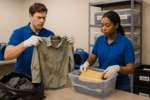How to Build Effective Referral Partnerships in Restoration

Restoration projects succeed or fail based on teamwork. As a general contractor, project manager, or restoration professional, you know that your reputation depends not just on your own work, but on every vendor and partner involved in the project.
This is especially true when it comes to textile restoration. The right soft goods partner can make your entire project run smoothly, while the wrong one can create delays, communication gaps, and unhappy clients. Here’s how to build partnerships and find restoration networks that consistently deliver better outcomes.
Why Restoration Networks Make or Break Projects
Your textile vendor choice reflects directly on your brand and professionalism. Consider what clients and adjusters experience:
With a Strong Partner or Restoration Network:
- Projects stay on schedule with predictable timelines
- Communication flows smoothly between all parties
- Documentation meets insurance requirements without delays
- Clients receive their belongings in excellent condition
- Your reputation for thoroughness and quality is reinforced
With a Weak Partner or Restoration Network:
- Projects face unexpected delays and scope creep
- Poor communication creates confusion and frustration
- Inadequate documentation leads to claim disputes
- Lost or damaged items create liability issues
- Your professional reputation suffers from their mistakes
The difference often comes down to how well you select and manage these partnerships.
Essential Qualities in a Textile Restoration Network
Not all textile providers are equipped to handle restoration work. When evaluating potential partners, look for these critical capabilities:
Restoration-Specific Experience
- Proven track record with fire, water, and mold damage scenarios
- Understanding of insurance requirements and documentation standards
- Experience working within tight restoration timelines
Professional Communication Standards
- Rapid response times (ideally within 24 hours)
- Regular project updates without requiring follow-up calls
- Clear documentation that supports your adjuster relationships
- Transparent billing practices with no surprise charges
Operational Reliability
- Consistent quality standards across different job types
- Ability to scale resources for large or time-sensitive projects
- Backup systems for peak periods or emergencies
Collaborative Approach
- Willingness to coordinate with your project timeline
- Flexibility to adjust delivery schedules around rebuild phases
- Support during client walkthroughs or inspections when needed
Building Partnership Success: Your Role
Strong partnerships require effort from both sides. Here’s how to set your textile partners up for success:
Early Involvement
Bring restoration network specialists into the conversation during initial assessment, not after the pack-out is complete. Early involvement allows them to:
- Properly assess scope and timeline requirements
- Coordinate pack-out schedules with structural work
- Identify potential issues before they become problems
Clear Communication
Share critical project information upfront:
- Overall project timeline and key milestones
- Specific delivery requirements or restrictions
- Client communication preferences and sensitivities
- Any unique challenges or considerations for the property
Consistent Messaging
Ensure all team members are aligned on client communication:
- Present a united front on timelines and expectations
- Maintain consistent messaging about process and progress
- Address any concerns through coordinated responses
Feedback Loop
Establish regular communication to continuously improve the partnership:
- Provide feedback on what’s working well
- Address issues promptly before they affect client relationships
- Share insights about changing market requirements or expectations
Red Flags to Avoid
Watch for warning signs that indicate a potential partner may not be restoration-ready:
- Slow response times during the evaluation process
- Reluctance to provide references from other restoration contractors
- Unclear pricing structure or unwillingness to discuss rates upfront
- Limited insurance experience or unfamiliarity with documentation requirements
- Poor communication skills or difficulty understanding project requirements
These issues rarely improve once you’re in the middle of a project.
Maintaining Long-Term Partnerships
The best restoration network referrals develop over time through consistent performance and mutual respect:
Regular Performance Reviews
Schedule periodic discussions to evaluate partnership effectiveness:
- Review recent project outcomes and client feedback
- Identify opportunities for improved coordination
- Discuss market changes or evolving requirements
Mutual Support
Strong partnerships involve supporting each other’s success:
- Refer clients to partners when appropriate
- Provide testimonials or references for their business development
- Collaborate on process improvements that benefit both parties
Professional Development
Stay aligned on industry standards and best practices:
- Share relevant training opportunities or industry updates
- Discuss new technologies or methods that could improve outcomes
- Maintain awareness of changing insurance requirements
The Bottom Line on Partnership Success
Effective referral partnerships and restoration networks don’t happen by accident—they require intentional selection, clear communication, and ongoing management. When you invest in building strong relationships with textile restoration providers, you create a competitive advantage that benefits everyone involved: faster project completion, better client satisfaction, and stronger professional relationships.
The key is treating textile restoration partners as integral members of your project team, not just vendors to be managed. This collaborative approach consistently produces better outcomes and builds the foundation for long-term business success.
Discover more guidance on the world of textile restoration on our blog or contact us for more information on becoming a partner.
Related Blogs


How to Effectively Communicate Textile Restoration Timelines to Policyholders


